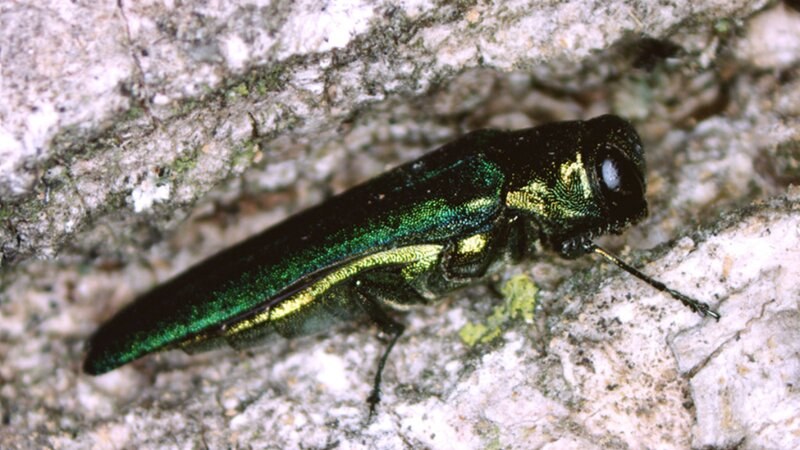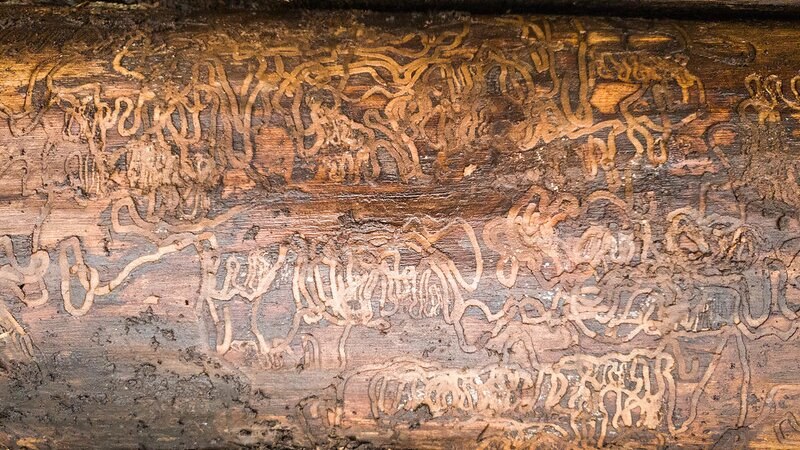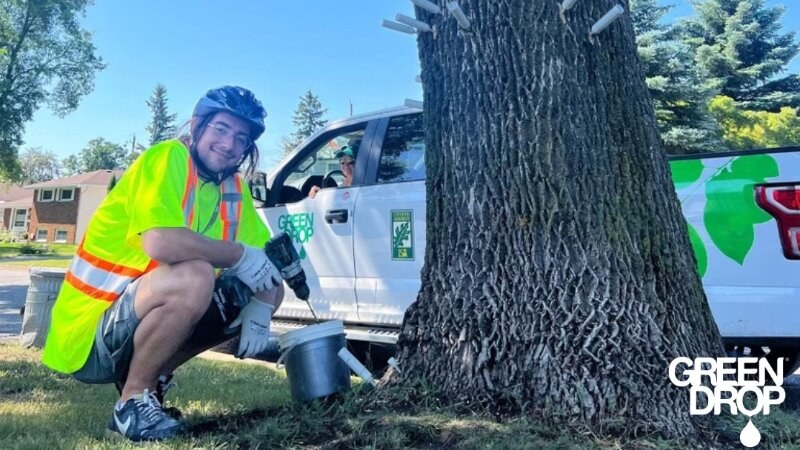Emerald Ash Borer - Calgary's Enemy #1 for Ash Trees
Reading time: 6 minutesThe Emerald Ash Borer (EAB) is a devastating pest that has wreaked havoc on ash trees across North America. In Calgary, where there are 76,000 public ash trees that play a crucial role in the urban landscape, the threat of EAB looms large.
According to the City of Calgary, the Emerald Ash Borer (EAB) has not yet been detected within the city. Despite this, the threat of an infestation exists. This invasive beetle damages the aesthetic and environmental value of the city and poses a significant risk to the health and longevity of Calgary's cherished ash trees.
Let’s take a few minutes to identify the EAB and outline potential treatment options to combat this invasive pest to preserve the urban canopy.

Emerald Ash Borer: Origins, Impact, and Threat
EAB is a small, metallic green beetle originally from Asia. It was first discovered in North America in 2002, and since then, it has spread rapidly, causing widespread destruction to ash trees. The spread of EAB across the continent can be attributed to the transportation of infested wood materials, such as firewood, highlighting the importance of local and regional quarantine efforts.
How serious is this? This beetle can kill up to 99% of ash trees within 8-10 years of arriving in an area.
EAB infests ash trees by laying eggs in bark crevices. When they hatch, the larvae burrow into the bark to feed on the inner tissues, disrupting the tree's ability to transport water and nutrients. This infestation leads to:
- Thinning canopies
- Branch dieback
- Eventually, tree death
Recent research has unveiled astonishing findings about EAB larvae's ability to survive extreme cold. The larvae use antifreeze proteins, such as glycerol, to prevent their blood from freezing, allowing them to withstand temperatures as low as –40°C.
It also showed that EAB larvae from colder regions like Winnipeg have developed increased cold tolerance. This means that these pests can adapt to local climate conditions, enhancing their survival and spread potential.
The implications are dire for cities like Calgary, where ash trees play a pivotal role in the urban canopy. Ash trees contribute to metropolitan areas' aesthetic and ecological fabric and provide critical habitat and food sources for various wildlife species.
The possibility that Calgary's frigid winters may not discourage the spread of EAB is definitely concerning and calls for proactive measures. This includes:
- Monitoring for early signs of infestation
- Employing strategies to protect uninfected trees
- Adopting approaches to mitigate the impact on affected trees
How To Identify an Emerald Ash Borer Infestation
Spotting infected trees early can be the difference between saving and losing an ash tree. Here are the major signs and symptoms to watch for:
D-shaped Exit Holes
The most distinctive sign of EAB is the D-shaped exit holes found on the bark of infested trees. These holes, about 1/8-inch in diameter, are where adult borers have exited the tree.
S-shaped Galleries
EAB larvae create winding, S-shaped tunnels or galleries under the bark. These disrupt the tree's ability to transport nutrients and water, leading to decline.
Canopy Thinning and Dieback
One of the first visible signs is the thinning of the tree's canopy, starting from the top down. As the infestation progresses, branches may die back.
Increased Woodpecker Activity
Woodpeckers find EAB larvae delicious. If you suddenly see an increase in woodpecker activity along with damage to your ash tree, this could mean that larvae are present.
One way to know for sure is by getting a professional assessment done by a team of ISA-certified arborists.

How to Protect Your Ash Trees from Emerald Ash Borer Infestation
Identifying and protecting ash trees from the EAB is like playing detective in your backyard. If you're not sure whether you're looking at an ash tree, look for these tell-tale signs:
- Opposite branching patterns
- Compound leaves with 5 to 11 leaflets
- Distinctive diamond-patterned bark
Once you've identified the tree type, it's time to protect them from EAB infestations.
Think of protection as setting up a wellness spa for your trees. Mulching, proper watering, and regular pruning are on the menu. This keeps the trees in tip-top shape and less appetizing to pesky invaders.
Managing & Removing Emerald Ash Borer From Your Trees
When the Emerald Ash Borer (EAB) makes its unwelcome entrance, you want to show them the exit immediately. We need a blend of vigilance, scientific insight, and a little elbow grease.
Mechanical and Physical Controls
Taking a hands-on approach to combat the EAB involves mechanical and physical interventions that can significantly impact the pest's lifecycle and spread.
- Tree Removal and Destruction. Infested ash trees often must be removed to prevent the EAB from maturing and spreading. After identifying an infestation, we need to carefully plan tree removal to avoid inadvertently spreading the borers. The wood from these trees should be chipped to a size smaller than 1 inch in two dimensions, which is effective in killing the larvae. Disposal methods must adhere to Calgary's local government regulations.
- Debarking. For trees cut down, debarking can eliminate EAB larvae and pupae residing under the bark. This process should be done diligently and in a manner that ensures all bark material is disposed of properly to prevent any larvae from surviving.
- Sanitation Pruning. Regularly inspecting trees for early signs of EAB infestation and removing affected branches can slow the spread within a tree and potentially save it from complete destruction. This method is particularly effective in the early stages of infestation.
Chemical Treatments
Chemical interventions offer a line of defence for trees at risk of EAB infestation or already under attack. When applied correctly, these treatments can prevent new infestations and suppress existing ones.
- Soil Injections. Insecticides applied to the soil around the base of an ash tree are absorbed through the roots and distributed throughout the tree's vascular system. This method effectively protects the tree for one to two years, depending on the product used. Soil injections are best applied in spring or fall when the tree transports water and nutrients actively.
- Trunk Injections. Direct injection of an insecticide called TreeAzin into the tree delivers the chemical into the tree's vascular system quickly and efficiently. This method can minimize exposure to non-target organisms and the environment. Trunk or branch injections require specialized equipment and should be performed by trained professionals. They offer two years of protection, making them a vital tool for managing EAB in high-value trees.
Integrated Pest Management (IPM)
This method combines biological and cultural tactics with the mechanical and chemical tactics stated above to provide a holistic approach to combat the EAB menace.
- Spraying the trunk and foliage with the entomopathogenic fungus Beauveria bassiana has shown promise when applied before adult emergence. However, there is insufficient data to assess how well this product protects trees from emerald ash borer attacks.
- Cultural strategies include altering the environment to make it less hospitable for EAB. This could mean choosing resistant varieties of ash trees for new plantings or diversifying the species in your landscape to reduce the buffet options available to these beetles.

Protect The Health of Your Calgary Trees with Green Drop
As the threat of the Emerald Ash Borer looms over Calgary's ash trees, taking action has never been more critical.
Green Drop offers specialized tree care and removal services, along with expert arborist consultations to help protect your trees from this invasive pest.
Whether it's preventive treatment to shield your trees or the careful removal of infested ones, our team is equipped with the knowledge and tools to provide the best care possible.
Don't wait until it's too late; safeguard your urban canopy today. Schedule a consultation and learn how our local certified arborists can help keep your trees healthy and vibrant.

